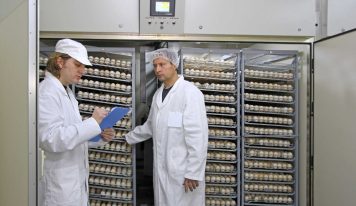Egg recalls for suspected or confirmed Salmonella occur despite existing procedures for several reasons. Despite strict European regulations and national control plans, the system is not foolproof, primarily due to the biological and ubiquitous nature of the bacterium and the ways in which contamination can occur even after inspections.
The main reasons for salmonella egg recalls
Precautionary or definitive recalls are often the result of a combination of two main contamination routes, which are difficult to intercept 100% before the product leaves the packing station:
Vertical (internal) contamination
This is the most difficult route to prevent and intercept. Let’s see why:
- Asymptomatic carrier hens: laying hens can be infected with the Salmonella bacterium (particularly the Salmonella Enteritidis strain) and remain asymptomatic.
- Egg transmission: the bacterium can colonize the hen’s reproductive tract and, although rare, can pass directly into the egg (yolk or white) before the shell forms.
- Testing limitations: control procedures rely on regular sampling of farms to test for the presence of the bacterium in the environment and in animal feces. However, it is impossible to test every single hen or egg for internal infection before sale, requiring booster shots following an epidemiological investigation or subsequent analysis.
Horizontal (external) contamination
This path, however, is linked to the hygienic conditions of the environment and post-deposition. Let’s look at it in detail:
- Contact with feces: salmonella is commonly found in bird feces. The egg, when laid, may come into contact with contaminated feces or dirty surfaces .
- Shell penetration: eggshells are porous. If the egg is not refrigerated or handled properly, or if it suffers microcracks during collection, transportation, or packaging, bacteria on the surface or packaging can penetrate the egg.
- Cross-contamination: contamination can also occur during the packaging phases (in the packing center) due to machinery that is not perfectly sanitized or due to contact with broken eggs, transferring the bacteria to batches that were not originally contaminated.
The role of procedures and recalls
Recalls aren’t necessarily a failure of procedures, but rather evidence that the surveillance system is lagging behind . But it works.
- Continuous monitoring: the European Union requires National Control Plans (Salmonella control programs) that include regular testing on farms and in feed. These plans significantly reduce the risk, but do not eliminate it.
- Traceability: the code printed on the shell of each egg allows complete traceability back to the farm of origin (the poultry sector is an example of a highly traceable supply chain).
- Recall as a safety net: when health authorities (such as the Ministry of Health in Italy) receive a notification of a positive Salmonella test (often following product testing or reports of salmonellosis outbreaks in consumers), traceability allows them to immediately identify the batch and farm and order a precautionary recall from the point of sale.
Therefore, recalls demonstrate that a biological risk, though rare and difficult to detect individually, can elude preventative controls, necessitating the activation of downstream safety procedures to protect public health. This means, however, that the poultry and human health systems are interconnected and constantly operational, because 100% safety can never be guaranteed and must be “pursued.”
Remember to always cook the eggs, however.
Cooking eliminates Salmonella.
You can also find more information about eggs here:
https://moreaboutchicken.com/?s=the+eggs+arrive+clean+in+the+incubators











